[[{“value”:”
Year-over-year, CPI and “core” CPI are starting to show the effects of the month-to-month increases since the “inflation is vanquished” summer.
By Wolf Richter for WOLF STREET.
On a month-to-month basis, the “core” Consumer Price Index – which excludes the volatile food and energy components – rose by 0.28% (+3.4% annualized) in October from September. The last three months have all risen in this range of +3.4% to +3.8% annualized, the biggest increase since March (blue in the chart below).
The 3-month average “core” CPI accelerated to 3.6% annualized, the third month of acceleration in a row (red).
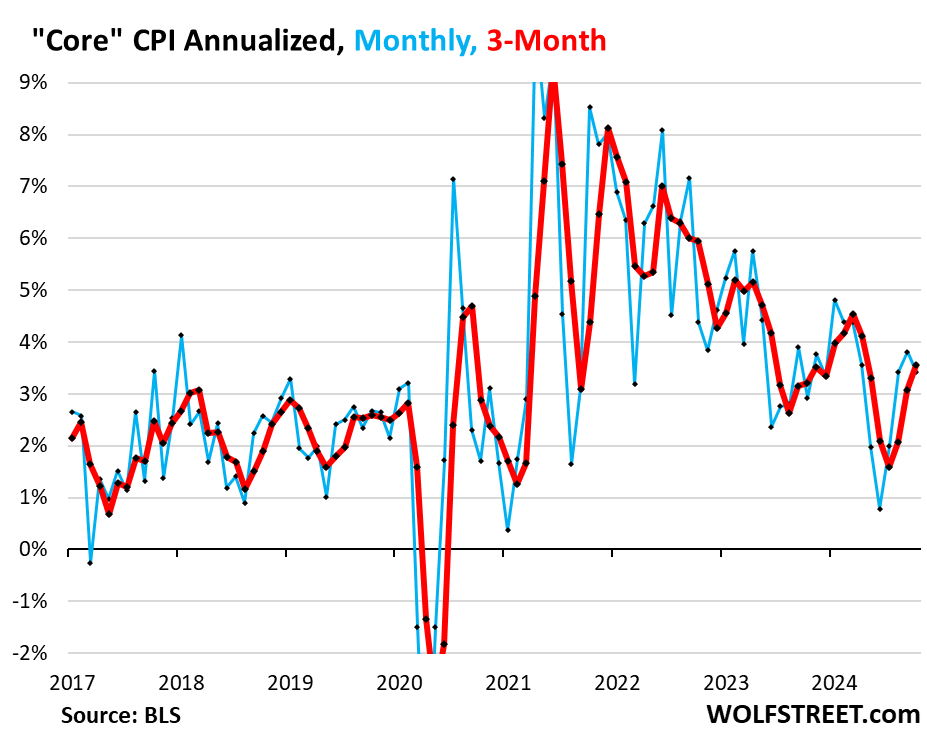
The stubbornly high core inflation rate was driven, so to speak, by the prices of used vehicles that rose for the second month in a row, having U-turned from a historic plunge, which had been one of the big contributors to cooling core inflation. But it appears to be over. Used vehicles have now turned into an inflation headwind, which we figured was coming our way, based on the rising prices at used-vehicle auctions where dealers buy to replenish their inventories.
In addition, the biggest factor in CPI that approximates the costs of homeownership – including the soaring expenses of homeowners’ insurance, HOA fees, property taxes, and maintenance – “Owners Equivalent of Rent” accelerated to nearly 5% annualized, and the three-month average accelerated to over 5%, even as the index that tracks actual rents decelerated.
The 6-month average “core” CPI – which irons out most of the month-to-month squiggles – remained at +2.6% as it still includes the low readings of May, June, and July that will fall out of the average over the next three months (red):
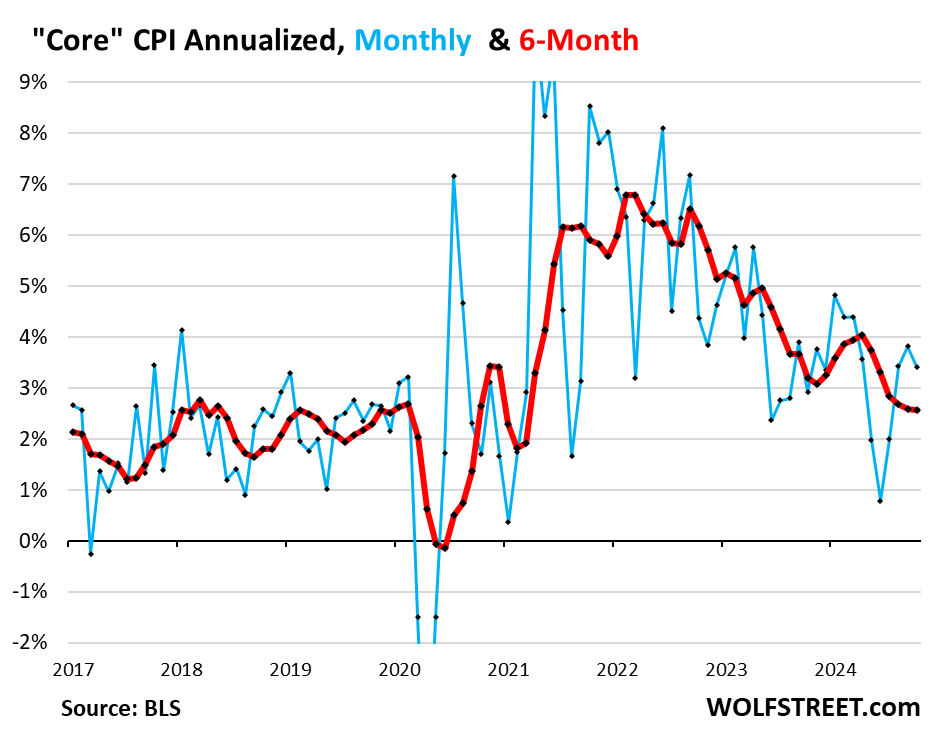
The overall CPI is still held down by the plunge in gasoline prices. But it accelerated to +3.0% annualized in October from September (+0.24% not annualized), the fastest increase since March, despite the drop in gasoline prices, and the fourth month in a row of acceleration.
The three month-average accelerated to +2.5%, also the third month in a row of acceleration.
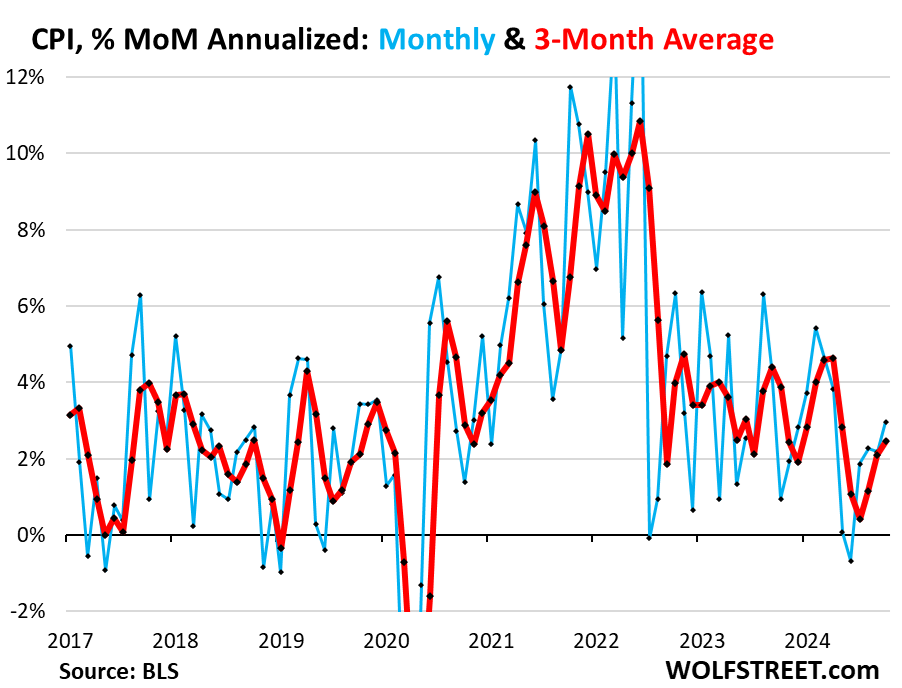
Year-over-year, CPI and core CPI accelerated:
- Overall CPI, despite the plunge in gasoline prices, accelerated to +2.6% (yellow).
- Core CPI accelerated slightly for the third month in a row to +3.3% (red in the chart below).
- Core Services CPI rose by +4.8%, same as in the prior month (blue).
- Durable goods CPI, which has been in deflation on a year-over-year basis since late 2022, became less negative, at -2.5% (from -2.9% in the prior month).
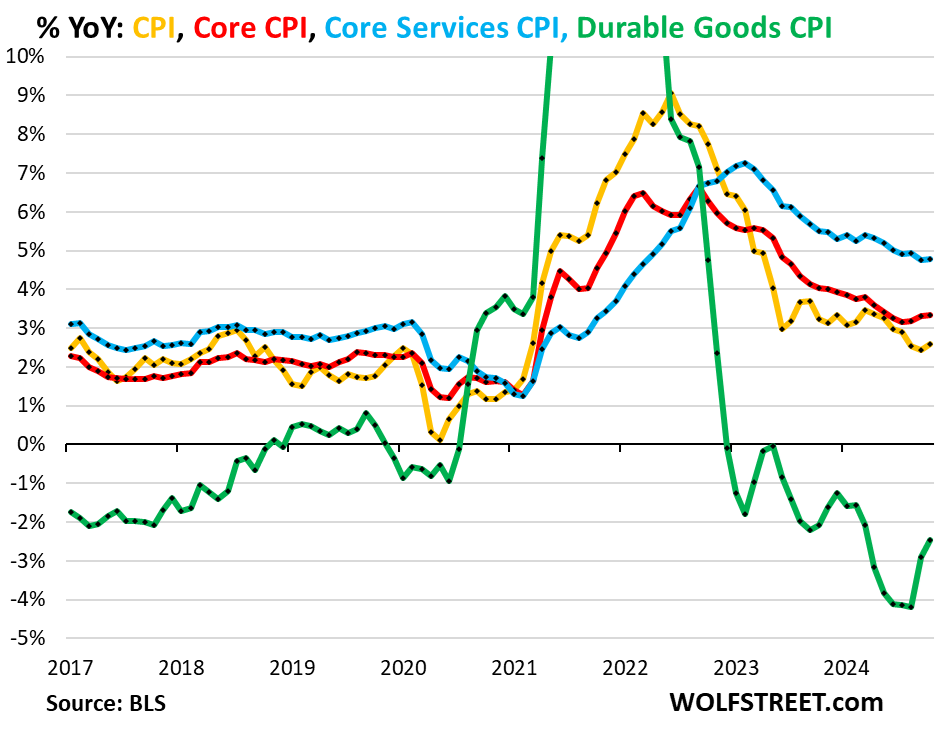
“Core services” CPI.
Core services CPI decelerated a hair to a still high +4.3% annualized in October from September, compared to +4.4% in the prior month (blue line in the chart below).
But the 3-month core services CPI accelerated to 4.5%, from 4.4% in the prior month (red).
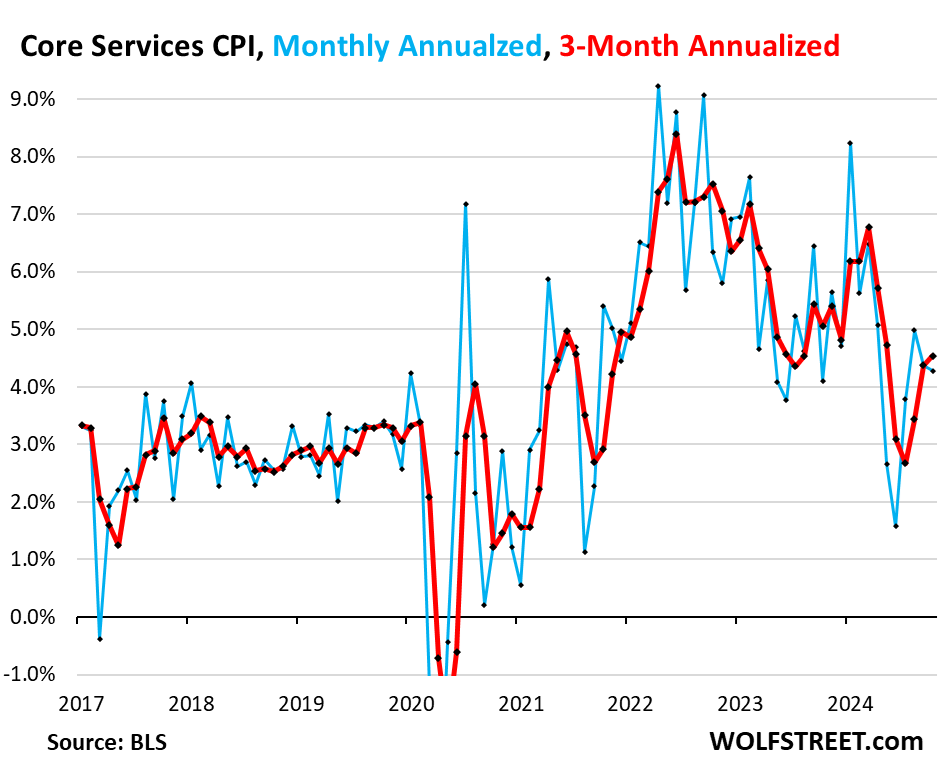
The 6-month core services CPI – which still includes the very low reading in May, June, and July that will fall out of the index over the next three months – decelerated a hair to 3.6% annualized, the smallest increase since January 2022 (red).
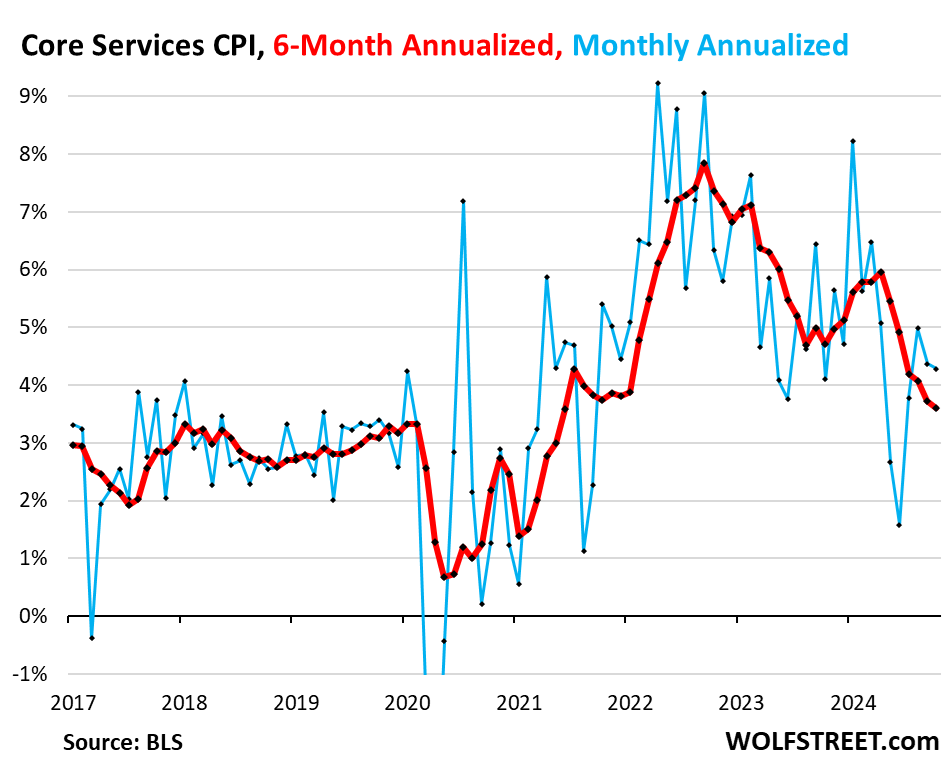
The housing components of core services.
The Owners’ Equivalent of Rent CPI (OER) indirectly reflects the now soaring day-to-day expenses of homeownership: homeowners’ insurance, HOA fees, property taxes, and maintenance. It is based on what a large group of homeowners estimates their home would rent for, with assumption that a homeowner would want to recoup their cost increases by raising the rent.
It accounts for 27% of overall CPI and estimates inflation of shelter as a service for homeowners – as a stand-in for the costs that homeowners pay for, such as interest, homeowner’s insurance, HOA fees, maintenance, and property taxes.
OER accelerated to 4.9% in October from September and has zigzagged around the 5% line all year (blue in the chart below).
The three-month OER CPI accelerated to 5.0% annualized, the third month of acceleration in a row (red).
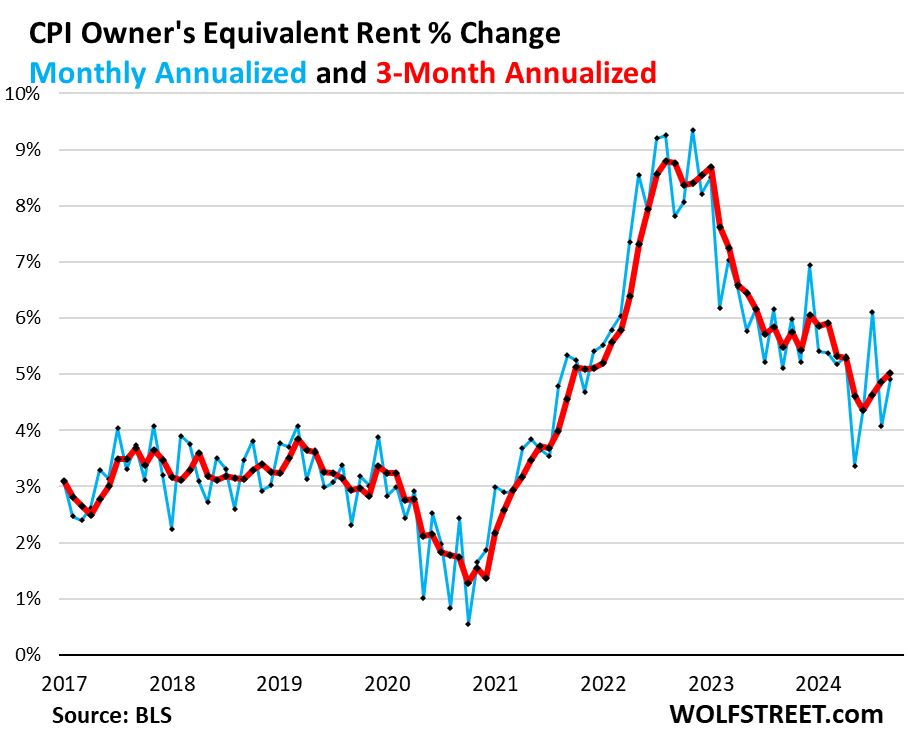
Rent of Primary Residence CPI accelerated to 3.6% annualized in October from September, up from +3.4% in the prior month (blue in the chart below).
The 3-month rate decelerated to +3.8% (from 4.6% in the prior month), as the high reading in July fell out of it.
Rent CPI accounts for 7.7% of overall CPI. It is based on rents that tenants actually paid, not on asking rents of advertised vacant units for rent. The survey follows the same large group of rental houses and apartments over time and tracks the rents that the current tenants, who come and go, paid in rent for these units.
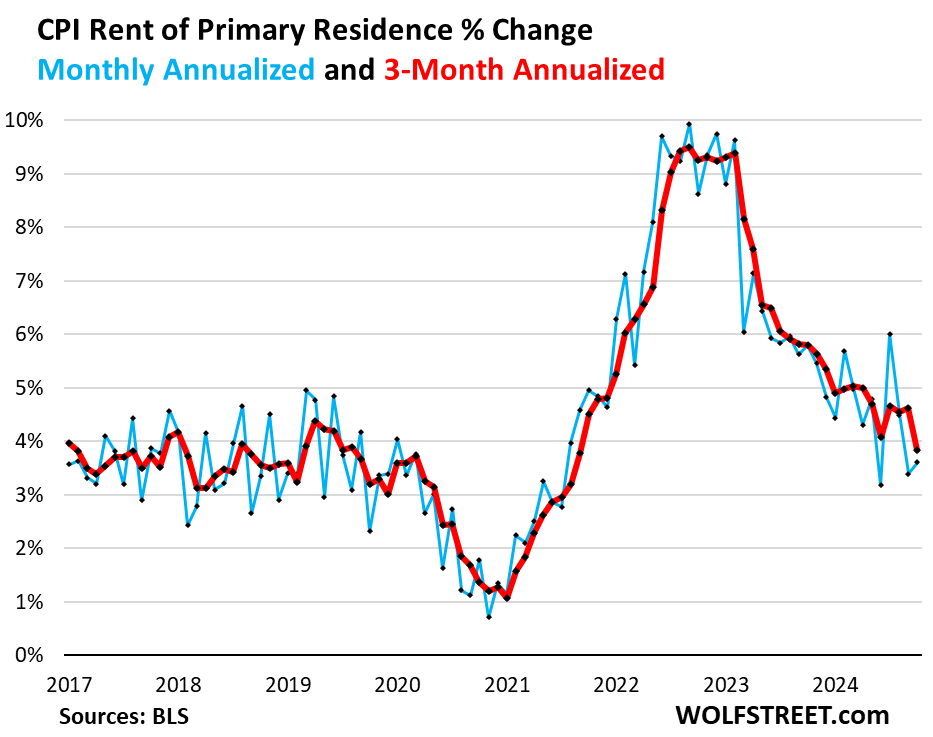
Unusually, the OER CPI has been diverging from the Rent CPI and has been running hotter than the Rent CPI since earlier in 2024 on a year-over-year basis, likely as homeowners started figuring into their estimates the soaring costs of insurance, HOA fees, property taxes, and maintenance.
Year-over-year, OER rose by 5.2%, same increase as in the prior month (red line). But the Rent CPI decelerated further to 4.6% (blue).
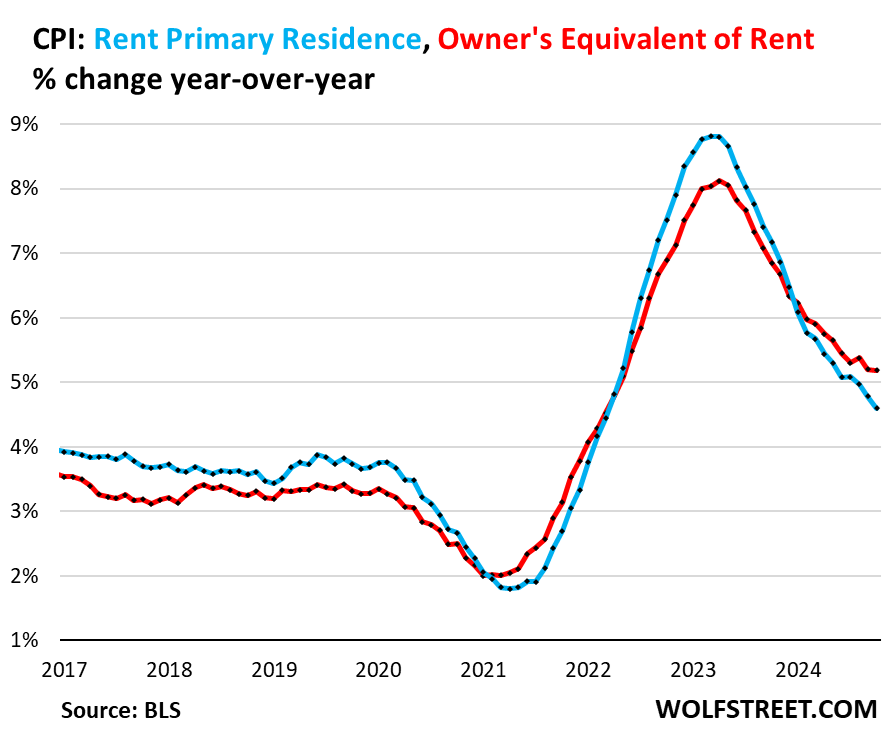
“Asking rents…” The Zillow Observed Rent Index (ZORI) and other private-sector rent indices track “asking rents,” which are advertised rents of vacant units on the market for rent. Because rentals don’t turn over that much, the spike in asking rents through mid-2022 never fully translated into the CPI indices because not many people actually ended up paying those jacked-up asking rents.
For October, the ZORI (seasonally adjusted) rose by 0.24% month-to-month and by 3.3% year-over-year.
The chart shows the CPI Rent of Primary Residence (blue, left scale) as index value, not percentage change; and the ZORI in dollars (red, right scale). The left and right axes are set so that they both increase each by 55% from January 2017.
Since January 2017, the ZORI rose by 50%, and the CPI Rent by 40%.
Since January 2020, the ZORI soared by 33% and the CPI rent by 26%.
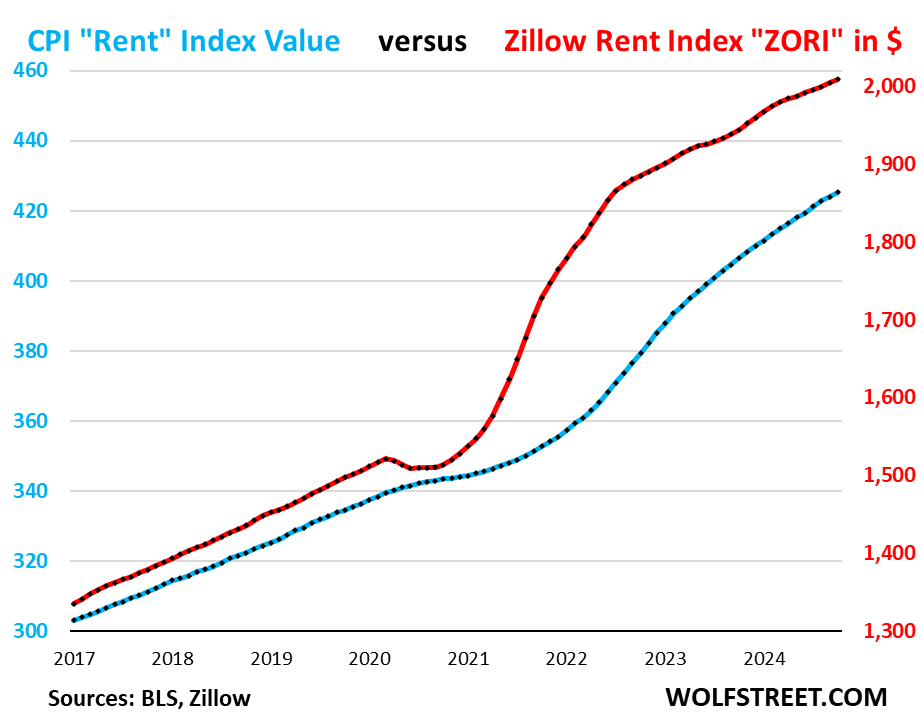
Rent inflation vs. home-price inflation: The red line in the chart below represents the CPI for Rent of Primary Residence as index value. The purple line represents Zillow’s “raw” Home Value Index for the US [this is also the data set we use for the Most Splendid Housing Bubbles in America ]. Both indexes are set to 100 for January 2000:
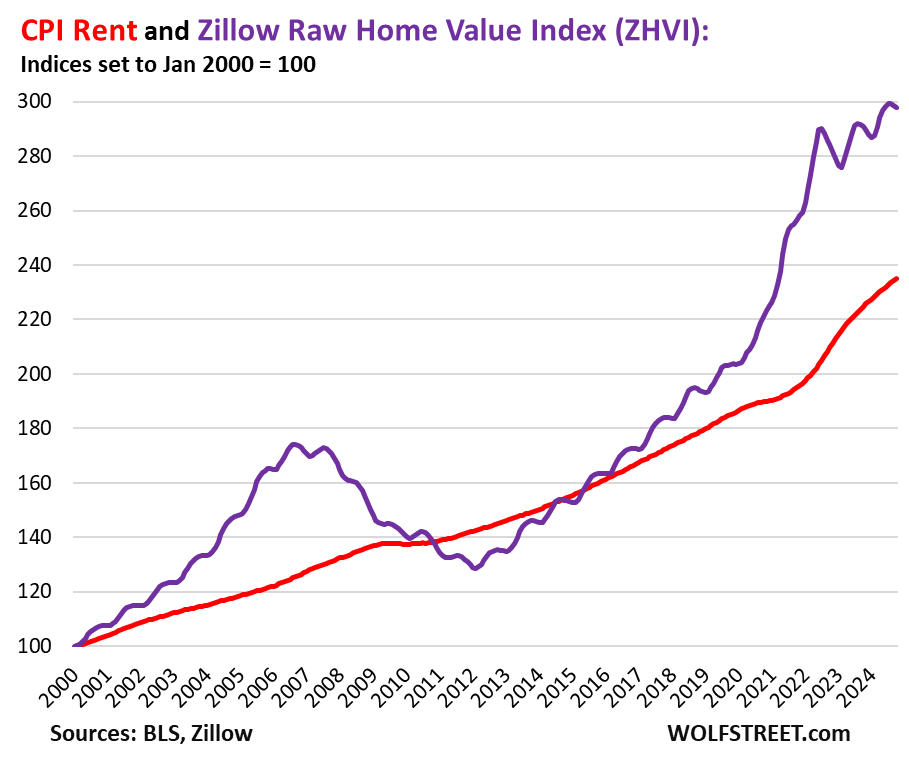
The CPI for motor-vehicle maintenance & repair spiked by 13.4% annualized (+1.05% not annualized), in October from September, after the 12.1% spike in the prior month, which pushed the year-over-year increase to 5.8%, the highest since June.
Since January 2020, it has spiked by 38% as labor costs of auto-repair technicians have surged, and as prices of replacement parts have surged.
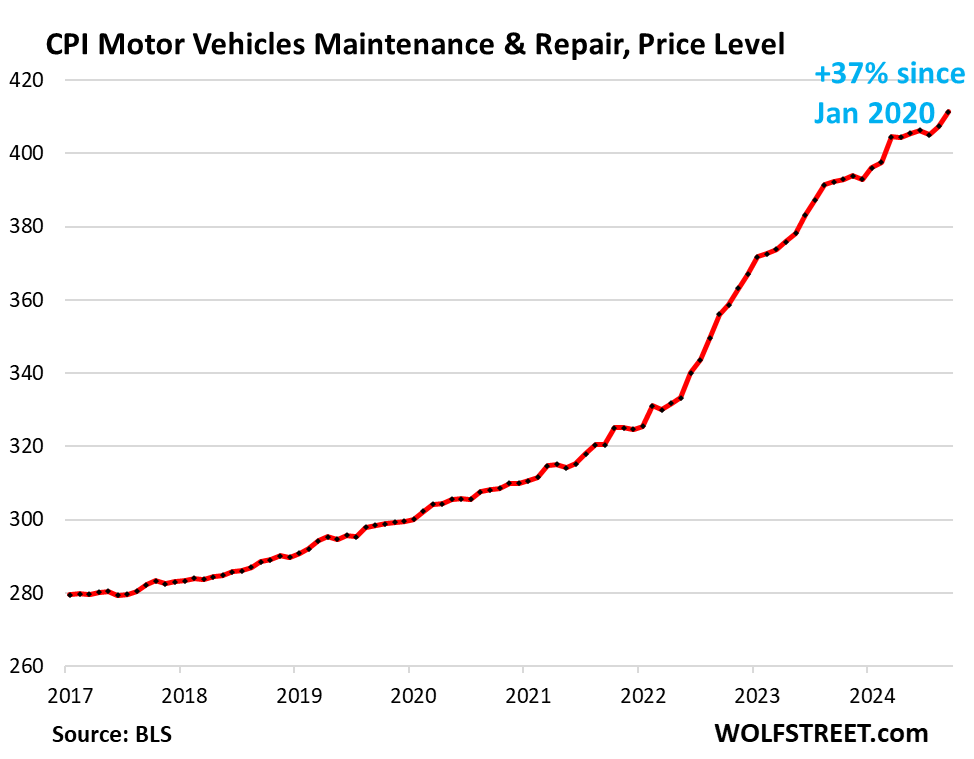
The CPI for motor vehicle insurance dipped in October, -1.3% annualized (-0.1% not annualized) after the 15% spike in the prior month.
Year-over-year, it rose by 14.0%. Since 2022, it exploded by 51%.
The massive inflation in motor vehicle insurance was fueled initially by the spike in repair costs and by the historic spike in used-vehicle prices (replacement values) in 2021 and 2022, though used-vehicle prices have plunged since then. Since 2023, insurers were able to fatten up their profit margins, which provided an additional boost of the CPI of motor vehicle insurance.
But the month-to-month pullback in October may be a quirk, given that it followed the big spike in September. There was a quirk like this in May, that was followed by four months of sharp increases:
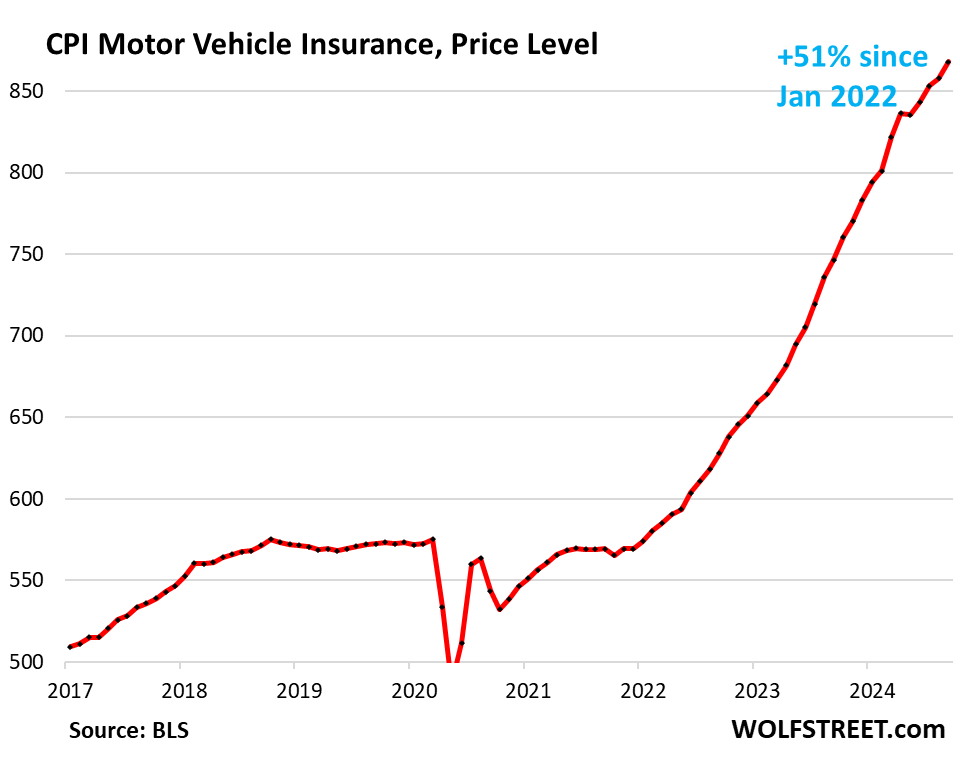
Food away from Home CPI – often called food services – includes full-service and limited-service meals and snacks served away from home, food at cafeterias in schools and work sites, food served at stalls, etc.
In October, it rose by 2.9% annualized from September (+0.24% not annualized) and by 3.8% year-over-year, the smallest increase since April 2021. Since January 2020, it has surged by 29%.
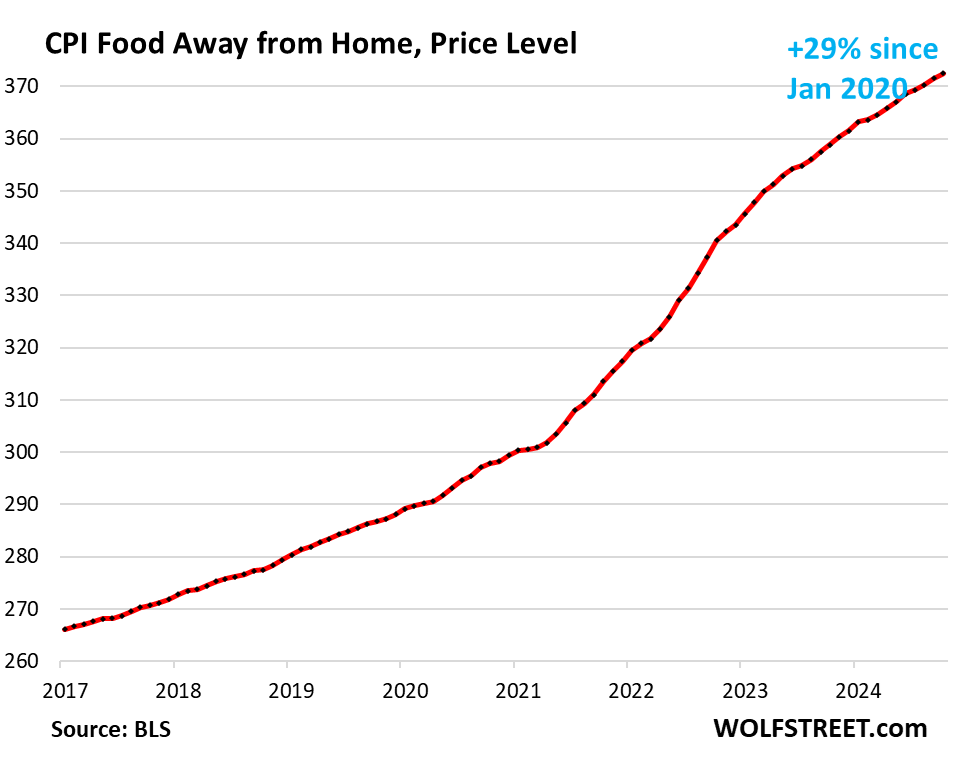
The Core services CPI overall has risen by 23% since January 2020.
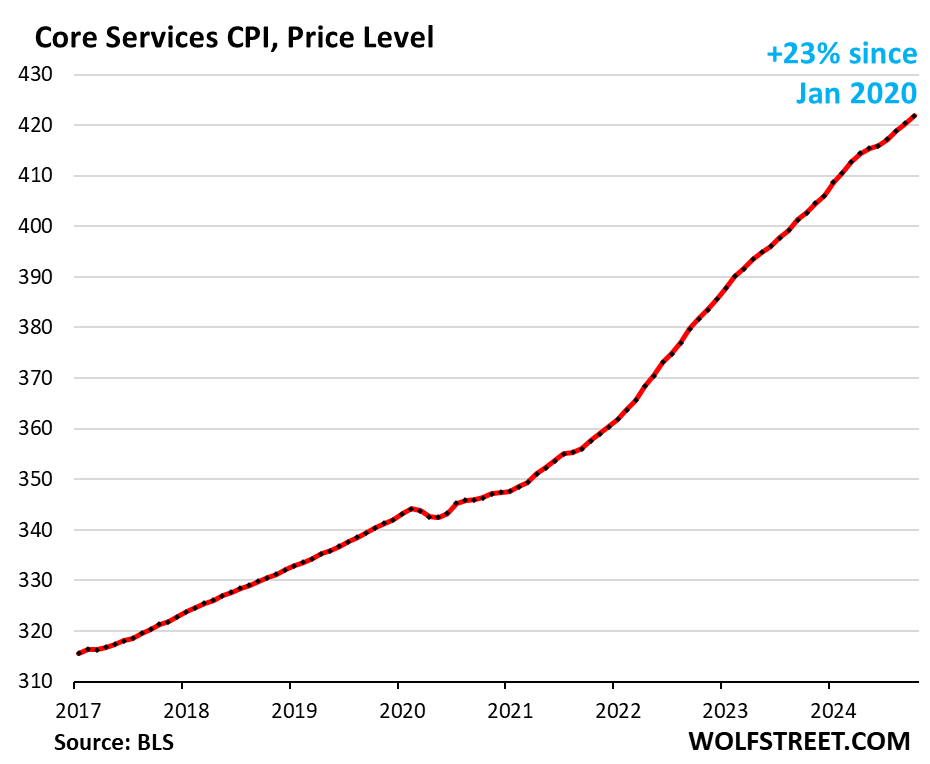
| Major Services ex. Energy Services | Weight in CPI | MoM | YoY |
| Core Services | 65% | 0.3% | 4.8% |
| Owner’s equivalent of rent | 27.0% | 0.4% | 5.2% |
| Rent of primary residence | 7.7% | 0.3% | 4.6% |
| Medical care services & insurance | 6.5% | 0.4% | 3.8% |
| Food services (food away from home) | 5.4% | 0.2% | 3.8% |
| Education and communication services | 5.0% | -0.2% | 2.1% |
| Motor vehicle insurance | 3.0% | -0.1% | 14.0% |
| Admission, movies, concerts, sports events, club memberships | 1.8% | 1.2% | 3.2% |
| Other personal services (dry-cleaning, haircuts, legal services…) | 1.5% | 0.3% | 4.1% |
| Lodging away from home, incl Hotels, motels | 1.4% | 0.4% | -0.1% |
| Motor vehicle maintenance & repair | 1.3% | 1.1% | 5.8% |
| Public transportation (airline fares, etc.) | 1.0% | 2.4% | 2.5% |
| Water, sewer, trash collection services | 1.1% | 0.5% | 5.0% |
| Video and audio services, cable, streaming | 0.9% | -0.4% | 1.5% |
| Pet services, including veterinary | 0.4% | 0.9% | 6.1% |
| Tenants’ & Household insurance | 0.4% | 0.7% | 2.5% |
| Car and truck rental | 0.1% | -1.6% | -7.0% |
| Postage & delivery services | 0.1% | 3.9% | 9.8% |
Durable goods.
New and used vehicles dominate, followed by other durable goods such as information technology products (computers, smartphones, home network equipment, etc.), appliances, furniture, fixtures, etc. All categories have been experiencing price declines starting in late 2022, after the price spike during the pandemic. But the sharp month-to-month price declines in motor vehicles ended in September.
The used vehicle CPI flipped. In October, seasonally adjusted used vehicle prices spiked by 2.7% from October (+38% annualized), and even rose not seasonally adjusted, which is unusual because October is seasonally the weakest month of the year in terms of prices.
This massive U-turn reduced the year-over-year price drop to -3.4%, from double-digit year-over-year drops over the summer.
The plunge of used vehicle prices since mid-2022 had been a powerful contributor to the cooling of core CPI. But it has now ended. And this erstwhile strong tailwind for cooling inflation has turned into a headwind.
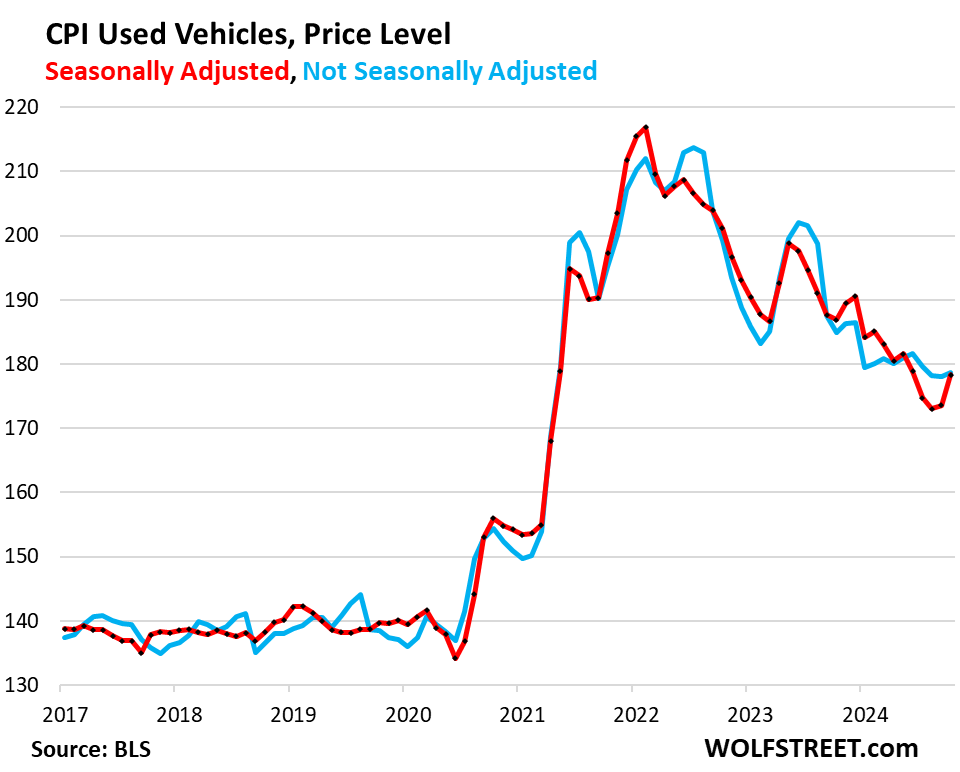
New vehicles CPI inched down by 0.6% annualized in October from September, after two months of small increases, seasonally adjusted (red). Year-over-year, the index fell by 1.3%. Since January 2020, the index is up 19%.
Unlike used-vehicle prices, new-vehicle prices have been sticky after the surge from early 2021 into early 2023 and have only given up a little ground since the peak, despite the glut of new vehicles on many lots. The big incentives and discounts that automakers and dealers are now throwing around to move their inventory essentially just undid out the big increases in MSRPs from the 2023 to the 2024 model year.
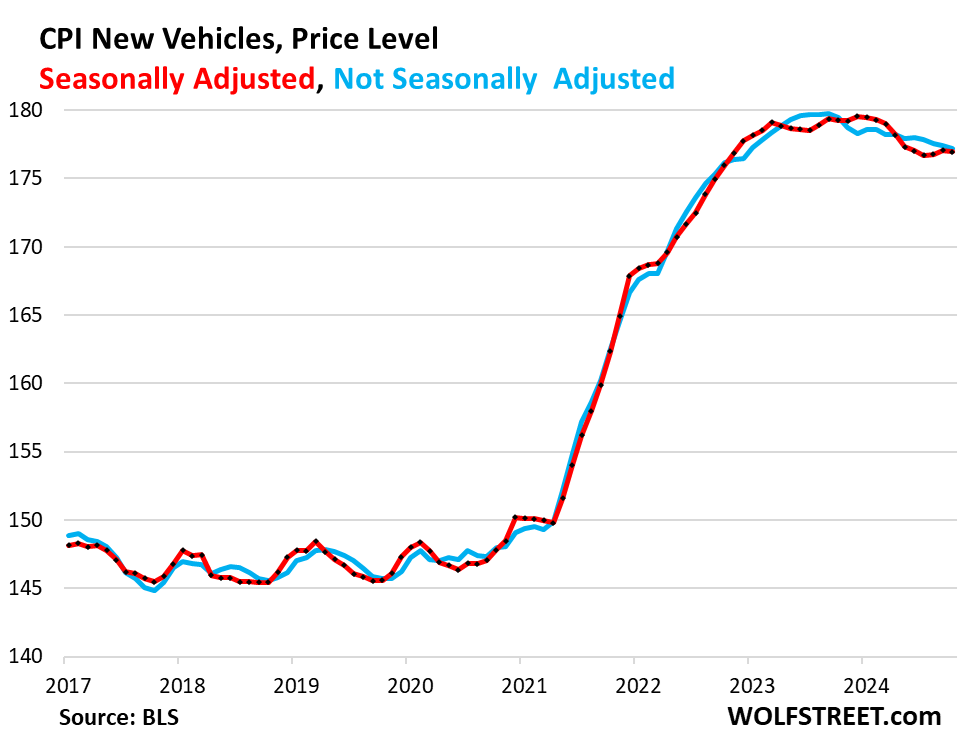
| Major durable goods categories | MoM | YoY |
| Durable goods overall | 0.1% | -2.5% |
| New vehicles | 0.0% | -1.3% |
| Used vehicles | 2.7% | -3.4% |
| Information technology (computers, smartphones, etc.) | -1.2% | -7.7% |
| Sporting goods (bicycles, equipment, etc.) | -0.5% | -3.1% |
| Household furnishings (furniture, appliances, floor coverings, tools) | 0.0% | -2.2% |
Food Inflation.
Inflation of “Food at home” – food purchased at stores and markets and eaten off premises – has flattened out in 2024 at a very high plateau. Inflation (a rate of change) has cooled, but prices remain aggravatingly high. The CPI for food at home is up by 26% since January 2020.
| MoM | YoY | |
| Food at home | 0.1% | 1.1% |
| Cereals, breads, bakery products | 1.0% | 0.9% |
| Beef and veal | -1.1% | 1.9% |
| Pork | -0.5% | -0.6% |
| Poultry | -0.1% | 0.0% |
| Fish and seafood | -0.3% | -1.5% |
| Eggs | -6.4% | 30.4% |
| Dairy and related products | 1.0% | 1.3% |
| Fresh fruits | 1.5% | 2.2% |
| Fresh vegetables | -0.7% | 0.5% |
| Juices and nonalcoholic drinks | 0.5% | 2.0% |
| Coffee, tea, etc. | 0.3% | 1.1% |
| Fats and oils | 0.1% | 2.4% |
| Baby food & formula | -0.7% | 0.9% |
| Alcoholic beverages at home | -0.3% | 1.1% |
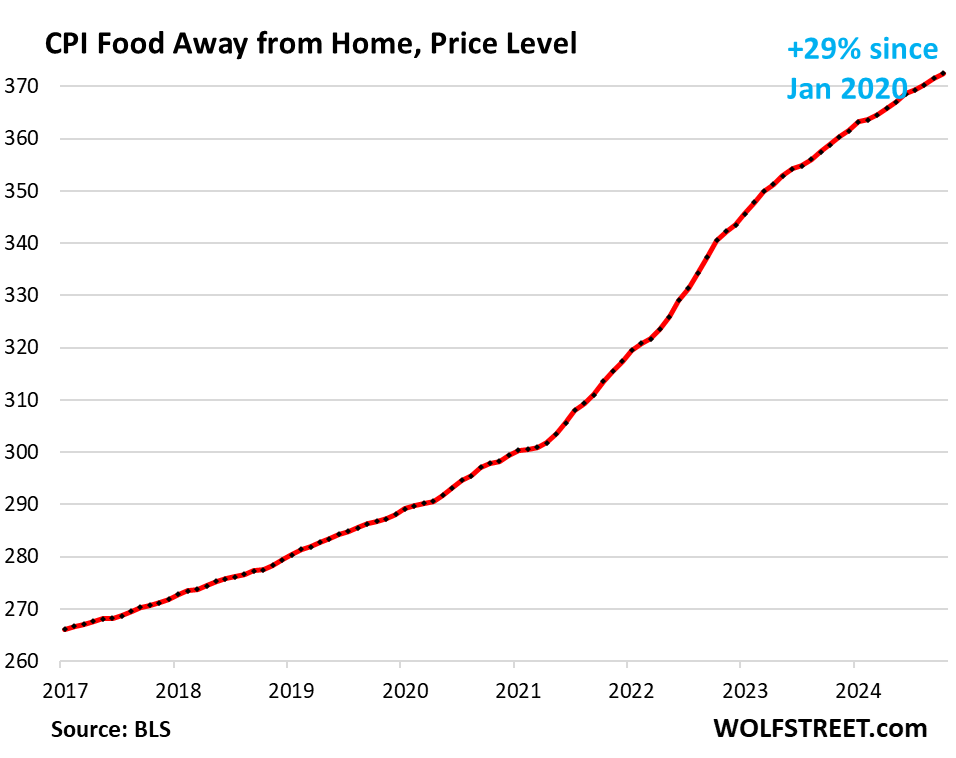
Apparel and footwear.
Apparel and footwear are components of nondurable goods, along with food, energy products, household supplies, and other stuff.
Month-to-month, the CPI for apparel and footwear dropped by 1.5% in October, undoing the spike in September.
Year-over-year, the index was essentially flat, despite some turbulence in between. The trend of deflation in the years before the pandemic seems to have ended:
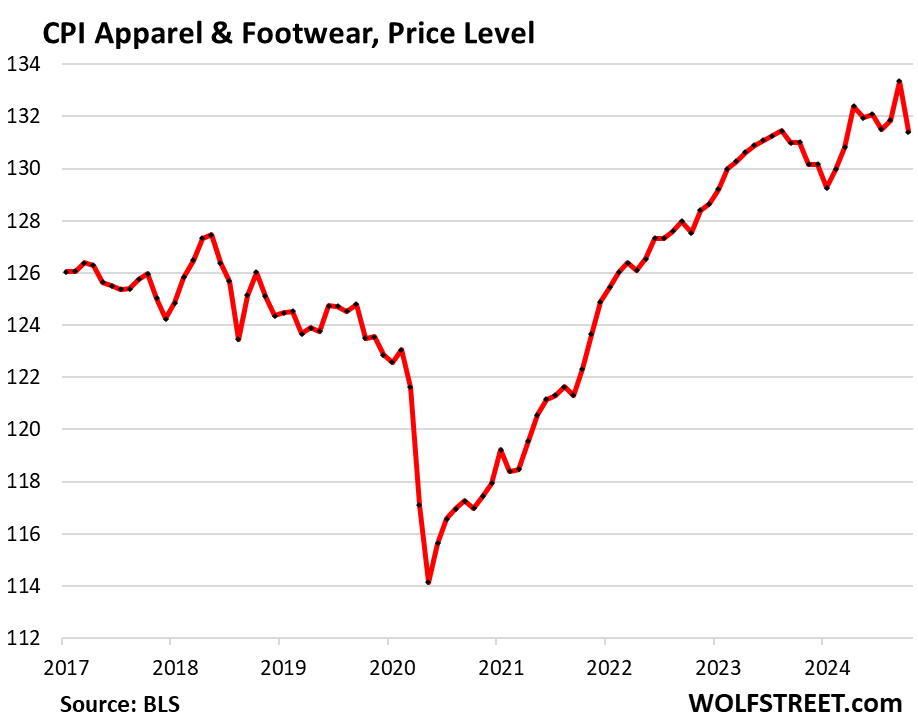
Energy.
| CPI for Energy, by Category | MoM | YoY |
| Overall Energy CPI | 0.0% | -4.9% |
| Gasoline | -0.9% | -12.2% |
| Electricity service | 1.2% | 4.5% |
| Utility natural gas to home | 0.3% | 2.0% |
| Heating oil, propane, kerosene, firewood | -2.2% | -11.9% |
The CPI for energy, which covers energy products and services that consumers buy and pay for directly, was essentially unchanged for the month on a drop in gasoline prices and a big increase in electricity prices.
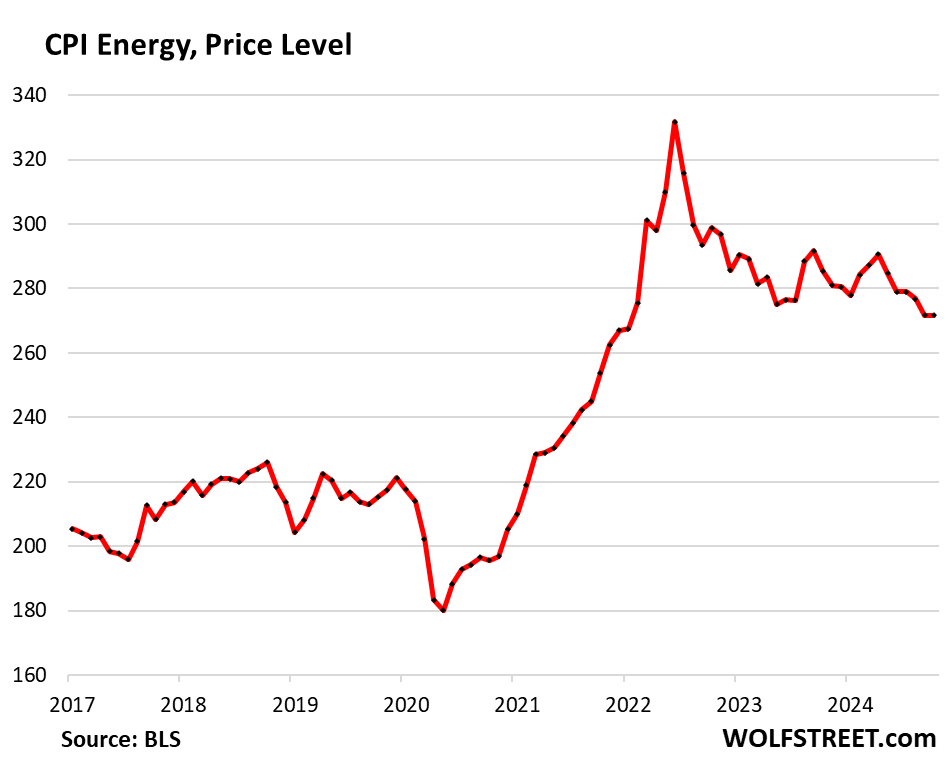
Gasoline prices, which account for about half of the energy price index, dropped further in October from September, both seasonally adjusted (red) and not seasonally adjusted (blue) and were down 12.2% year-over-year and down by 35% from the peak in June 2022. This was the big factor in driving down overall CPI:
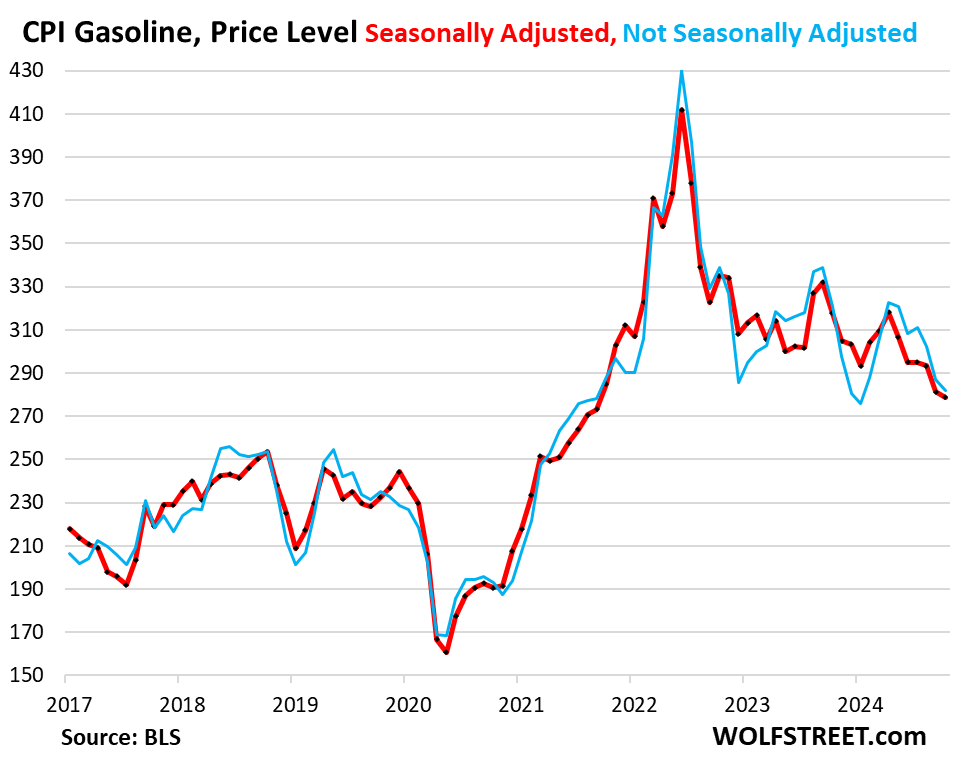
Enjoy reading WOLF STREET and want to support it? You can donate. I appreciate it immensely. Click on the beer and iced-tea mug to find out how:
Would you like to be notified via email when WOLF STREET publishes a new article? Sign up here.
![]()
The post Beneath the Skin of CPI Inflation: Overall CPI Accelerates for 4th Month, “Core” CPI for 3rd Month on Re-spiking Used Vehicle Prices & Rising Homeowner Costs appeared first on Energy News Beat.
“}]]
Energy News Beat

